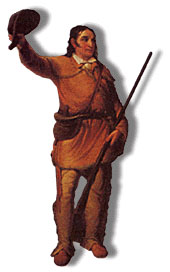Mythologizing The Alamo
by Richard G. Santos
 The
Honorable David Crockett of Tennessee did not die a la John Wayne. He was captured
and executed immediately after the battle of the Alamo on March 6,1836. Colonel
William Barrett Travis did not draw a line while asking the Alamo defenders
to choose between surrendering, attempting to escape or fighting to the last
man. There were not 180, or the latest number, 189 but most likely between 250
and 257 Alamo defenders.
The
Honorable David Crockett of Tennessee did not die a la John Wayne. He was captured
and executed immediately after the battle of the Alamo on March 6,1836. Colonel
William Barrett Travis did not draw a line while asking the Alamo defenders
to choose between surrendering, attempting to escape or fighting to the last
man. There were not 180, or the latest number, 189 but most likely between 250
and 257 Alamo defenders.
It is not true that there were no male survivors among the Alamo defenders. At least four managed to escape the final battle, and two have been positively identified.
One, Henry Warnell, managed to reach La Vaca, where he died of wounds suffered during the final battle and his escape. His records can be found in the General Land Office and the Texas State Archives.
The other, San Antonian Brigado Guerrero, belonged to Captain Juan Seguin's unit serving under Travis. In 1861, he finally received his military service pension from the state of Texas as the only known documented survivor of the Alamo defenders. His papers are in the Bexar County Archives, office of the county clerk.
There never was a Moses Rose and consequently, there never was a man who chose to abandon the Alamo garrison by jumping over the wall and sneaking off into the darkness.
Finally, 13,000 Mexican soldiers did not attack the Alamo or suffer casualties of 1,500 to 6,000 men.
Each of the above was the creation of tale tellers who, for whatever reason, chose to embellish, twist or obscure the facts about the battle at the Alamo.
Take the case of Felix Nuñez, who identified himself as a sergeant in General Eugenio Tolsa's Second Infantry Brigade and a participant in the battle of the Alamo. In his book,"Exploring the Alamo Legends," Wallace O. Chariton relied heavily on Nuñez to contradict the eyewitness accounts regarding Crockett's execution. Numerous other self-proclaimed historians have done likewise.
Yet, Nuñez's account is so full of errors and exaggerations that it is inconceivable that anyone would give it any consideration whatsoever. Above all, Tolsa's command, to which Nuñez supposedly belonged, did not arrive in San Antonio until five days after the battle, and none of his men participated in the final assault.
Travis' slave, Joe, in his first account of the siege, and battle stated he stayed in a room and could not see any action. Later, he is credited with saying that after being shot, Travis managed to sit up and run a sword through General Ventura Mora. Mora, acting general of the cavalry during the siege, was posted on the Gonzales Road and did not participate in the final assault of the Alamo. Moreover, he lived to a ripe old age and saw action in the U.S.-Mexican War of 1846-1848.
Likewise, Susannah Dickinson originally stated she stayed in one of the rooms of the Alamo church and did not see any of the siege or final assault. Later, when rediscovered by the press and sensationalist writers, she continuously changed her "recollections" to fit whatever new story was in fashion. Her life and that of her daughter, Angelina, immediately before and long after the battle of the Alamo are tragic stories best left in peace.
Santa Anna committed approximately 1,850 men to the final battle, in which he suffered approximately 550 casualties. By military strategy, an assault unit can expect to lose up to one-third of its force, Santa Anna did just that. On the other hand whether the defenders numbered 189 or, more likely, 250, they lost on a 1 to 2 ratio, which is not bad.
Apart from the Alamo Plaza hawkers such as Nuñez who preyed on unsuspecting tourist and writers, no other person did more to create Alamo myths that William Zuber.
In 1873, a full 37 years after the battle, Zuber published his account of Travis drawing the line and the escape of Moses Rose. The reaction was so swift to his ludicrous account that Zuber admitted he had made up part of the story. Although, he never clarified which part he made up, there is no evidence pointing to the existence of any man named Moses Rose.
There was, however, a man named Stephen, alias Louis Rose, living in Nacogdoches in the 1840s who was known as a drunkard, liar and person of ill-repute. He apparently was engaged in fraudulent land claims and kept using different first names.
He claimed to have been at the Alamo before the final assault. Unfortunately for him, some of his Nacogdoches neighbors also attested that he had never left the town and was well-known for his wild claims and exaggerations.
In spite of the fact that legends myth and fiction have obscured the documented record of what really happened at the Alamo between February 23 and March 6, 1836, the men of the Alamo garrison were, and will rightfully continue to be known, as heroes.
With or without the drawing of a line, or whether killed in battle or executed immediately thereafter, the men of the Alamo garrison died heroically.
--Richard G.Santos is an international research
historian, linguist and educator based in San Antonio.
Source:
"Mythologizing The Alamo", Express News (San Antonio, Texas: Saturday,
March 3, 1990, page 6-C)